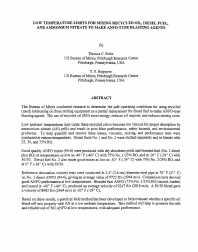Mining Publication: Low Temperature Limits for Mixing Recycled Oil, Diesel Fuel, and Ammonium Nitrate to Make ANFO-Type Blasting Agents
Original creation date: February 1996
Research was conducted to determine the safe operating conditions for using recycled (used) lubricating oil from mining equipment as a partial replacement for diesel fuel to make ANFO-type blasting agents. The use of recycled oil (RO) saves energy, reduces oil imports, and reduces mining costs. Low ambient temperatures may cause these recycled oils to become too viscous for proper absorption by ammonium nitrate (AN) prills and result in poor blast performance, safety hazards, and environmental problems. To help quantify and resolve these issues, viscosity, mixing, and performance tests were done at various temperatures. Diesel fuels No. 1 and No. 2 were studied separately and in blends with 25%, 50%, and 75% RO. Good quality ANFO mixes (94-6) were produced with dry absorbent prills and blended fuel (No. 1 diesel plus RO) at temperatures as low as -40 deg F (-40 deg C) with 75% No. 1/25% RO and at -20 deg F (-29 deg C) with 50/50. Diesel fuel No. 2 also made good mixes as low as -30 deg F (-34 deg C) with 75% No. 2/25% RO and at 0 deg F (-18 deg C) with 50/50. Reference detonation velocity tests were conducted in 1.4-in (3.6-cm) diameter steel pipe at 70 deg F (21 deg C) on No. 1 diesel ANFO (94-6), giving an average value of 9,722 ft/sec (2,964 m/sec). Comparison tests showed good ANFO performance at low temperatures. Blended fuel ANFO (75% No. 1/25% RO) mixed, loaded, and tested at -40 deg F (-40 deg C) produced an average velocity of 9,247 ft/sec (2,818 m/sec). A 50/50 blend gave a velocity of 8,083 ft/sec (2,464 m/sec) at -20 deg F (-29 deg C). Based on these results, a practical field method has been developed to help evaluate whether a specific oil blend will mix properly with AN at a low ambient temperature. This method will help to promote the safe and reliable use of RO ANFO at low temperatures with adequate performance.
Authors: TC Ruhe, TS Bajpayee
Conference Paper - February 1996
NIOSHTIC2 Number: 20024509
Proceedings of the 22nd Annual Conference on Explosives and Blasting Technique (Orlando, FL, Feb. 4-8, 1996). Vol. 2. Cleveland, OH: International Society of Explosives Engineers, 1996; :232-243
See Also
- Aerosols Emitted in Underground Mine Air by Diesel Engine Fueled with Biodiesel
- A Century of Bureau of Mines/NIOSH Explosives Research
- The Effects of Ventilation and Preburn Time on Water Mist Extinguishing of Diesel Fuel Pool Fires
- The Effects of Water Emulsified Fuel on Diesel Particulate Matter Concentrations in Underground Mines
- Factors Affecting Fumes Production of an Emulsion and ANFO/Emulsion Blends
- A Gas Pressure-Based Drift Round Blast Design Methodology
- Thermal Stability of ANFO Made with Recycled Oil
- Toolbox Training on Flyrock Awareness
- Toxic Fume Comparison of a Few Explosives Used in Trench Blasting
- Work-Principle Model for Predicting Toxic Fumes of Nonideal Explosives
- Page last reviewed: 9/21/2012
- Page last updated: 9/21/2012
- Content source: National Institute for Occupational Safety and Health, Mining Program


 ShareCompartir
ShareCompartir
